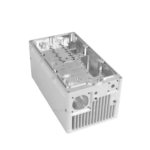Getting out of the workshop is actually a necessary step that a robot cannot avoid, just as socialism is the primary step of communism (although this statement is rarely mentioned now, you must have the policy memorized. It is a process).
As a mechanical engineering student, we often hear teachers (who may have never done it themselves) and seniors say: we need to go to the workshop more, without experiencing workshop training, we cannot mature and progress.
It seems that a design engineer who has never been to a workshop is like a newlywed who got married without falling in love, without any reliable basis. So today, as someone who has been there, I want to talk about why we go down to the workshop and what we do there?
What does the workshop look like?
To most people, the workshop is just the roar of machinery, with oil stains all over the floor and walls. Old equipment and numb workers mechanically perform the same processing work. The only thing that can get some life back is work. slight mark on the wall. Some encouraging slogans, not painful but full of dust, as if it has never been cleaned, and it seems that there is no need to clean it, because there are dirtier places everywhere, but it looks so clean. get up.
In your mind, it seems like you can’t find a worse work environment than here. It’s hard to accept even watching it, let alone working in this environment for a few years. If you’re unlucky, you may have to work. for a lifetime. What kind of self-punishment is this? A thought of life doubt comes to mind: God, what have I done wrong?
Imagine these promotional videos of Internet companies, high offices, and the most shameful thing is that they also have gyms and cafes. The computers are all equipped with the latest configurations, the seats have rotating and folding functions, and your favorite books are always placed. on the desktop. Flowers and favorite toys. What’s even more outrageous is that some companies allow you to bring pets to work, it’s clearly on vacation. Some bosses are so evil that they can let you work anywhere. time. You are here to do charity. Yes.
To a large extent, the workshop has become a nightmare for contemporary students. It is a place of inner resistance. Even many people who want to get involved or are currently involved in the machinery industry hate the shop and avoid it.
In fact, we still need to have a deeper understanding of this industry. Although modern manufacturing enterprises have certain shortcomings in their working environment and industrial processing compared with many Internet enterprises, with the progress of technology and industry 4.0, with the accelerated popularization, many enterprises have achieved unprecedented progress in automation and intelligence.
Modern factories, clean, bright workshops with constant temperatures, and busy but industrious robots have largely replaced manual operations. Workers have improved significantly in terms of work intensity and working environment. They are more like a driver using smart equipment and handles. anything that seems complicated easily and professionally.
And it is definitely a major trend in the future, and it is inevitable for the development of manufacturing enterprises. The factories that many students visit during their internships and internships are mostly old and dilapidated companies.
This is because your school can only contact such companies due to resource constraints, or in other words, only those companies without much technical content will be moderately open to you, while many high-end automation companies range are confidential due to their technology. open to outsiders, even employees of one’s unit, and those who do not have authority and do not need work are not allowed to enter.
Many Industry 4.0 companies have similar regulations. Due to the organization of production and the flow of processes, many professionals can learn everything at a glance, but those who are the first to tackle these technical and process issues are the companies and teams that spend a lot of money. human and material resources to resolve key issues, and others can easily learn from them. This is obviously not cost-effective and is not permitted.
For example, in Japanese companies, while discussing with a Japanese sales engineer about threaded rods and linear rails, I asked what level of automation Japanese companies in the same industry had achieved. clients They simply do not receive the complete picture of the project.
He only talks about the area he is responsible for. Entry into their business also requires specific authorization. Photography and videography are not permitted. (Japanese people speak Mandarin very well. Chinese is a very difficult language to master. , they said I can’t really tell it’s Japanese, so we Chinese still have to work hard, success doesn’t doesn’t come overnight).
This has gone too far. Everything went to Japan. Let’s return to our initial subject: why do you want to leave the workshop and what are you going to do? This is confusing to many people. in two aspects. This is also my personal question.
what do you need to learn
The first is a mechanical processing workshop. What do you need to learn about mechanical processing?
1. Familiar with the processing capabilities and processing scope of various processing equipment
We usually see equipment in ordinary workshops such as lathes, milling machines, planers, grinders, boring machines, drilling machines, laser cutting machines, wire cutting machines, etc. What processes are they used for processing and what is their processing accuracy?
What is the state of the advanced technology of these devices (you can easily learn it on the Internet), what state and level is your factory, what is the state and level of your city, and this industry, It is ? very useful for the design of your future product.
2. Familiar with product processing technology
For example, how treatment procedures are organized, what types of tools and accessories are needed for each procedure, and how equipment treatment parameters are adjusted.
Whether the processing accuracy is consistent with the drawings, how to check whether the processed part is qualified, what kind of inspection tools to use for inspection, etc. These questions need to be thought through and accumulated. This is also basic and common sense. for your future creations.
3. Learn to use processing equipment
Even though you don’t need to be very knowledgeable, you need to know how this thing works and think about how the structure of these devices is handled.
If you were to design these devices, how would you manage them? Is there a better structure and method of treatment than today? When using the equipment, you will discover the flaws and advantages of the equipment, and then absorb and transform them? in your own abilities.
Daguang focuses on providing solutions such as precision CNC machining services (3-axis, 4-axis, 5-axis machining), CNC milling, 3D printing and rapid prototyping services.









